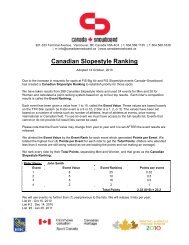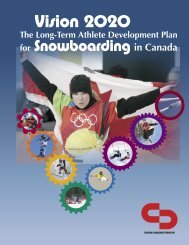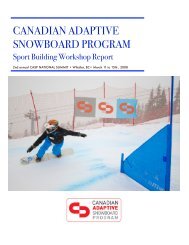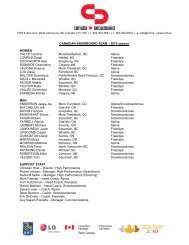CONCUSSION MANAGEMENT PROTOCOL ... - Canada~Snowboard
CONCUSSION MANAGEMENT PROTOCOL ... - Canada~Snowboard
CONCUSSION MANAGEMENT PROTOCOL ... - Canada~Snowboard
Create successful ePaper yourself
Turn your PDF publications into a flip-book with our unique Google optimized e-Paper software.
<strong>CONCUSSION</strong> <strong>MANAGEMENT</strong> <strong>PROTOCOL</strong><br />
2011-‐2012<br />
A <strong>CONCUSSION</strong> is a disturbance in the functioning of the brain caused by direct trauma<br />
to the head, face or neck; or following a blow elsewhere on the body that transmits an<br />
“impulsive force” to the head. This results in the rapid onset of a short-‐lived impairment<br />
of neurologic function that resolves spontaneously. There may or may not be a loss of<br />
consciousness (LOC); but frequently there is retrograde amnesia (difficulty recalling<br />
events immediately prior to the injury), and/or anterograde amnesia (difficulty recalling<br />
events which occur following the concussive injury). Athletes suffering from a<br />
concussion can display a wide variety of signs and symptoms, some of which can be very<br />
subtle. Resolution of clinical and cognitive symptoms typically occurs gradually, over a 7-‐<br />
10 day period. However, some athletes may also have a more prolonged recovery.<br />
There is currently no way to predict this in advance. It is also common that further (new)<br />
concussive injuries can cause the same or worse symptoms, with increasingly less force<br />
– especially if the athlete returns to training/competition before the brain is fully<br />
recovered. <strong>CONCUSSION</strong> HAS THE POTENTIAL TO BE A CAREER ENDING INJURY and for<br />
this reason we are taking extra precaution on the return to snow protocol and your<br />
health.<br />
POST CONCUSSIVE SYMPTOMS<br />
Post concussive symptoms can be physical, cognitive and emotional.<br />
Physical or “somatic” symptoms – include headache, nausea, and dizziness, ringing in<br />
the ears, double vision or other visual disturbances.<br />
Cognitive symptoms – include confusion, amnesia, disorientation, poor concentration,<br />
memory disturbance.<br />
Emotional symptoms – include depression, moodiness.<br />
There can also be problems with coordination and balance (vestibular function).<br />
Suite 301-333 Terminal Avenue, Vancouver, BC V6A 4C1<br />
info@canadasnowboard.ca www.canadasnowboard.ca
PRE-‐SEASON ASSESSMENT<br />
All athletes shall undergo a pre-‐season medical and physiotherapy examination, which<br />
will include baseline oculo-‐vestibular screening (balance testing), a SCAT2 test<br />
(Standardized Concussion Assessment Tool) 1 and neurocognitive testing with the<br />
computer-‐based ImPACT test (Immediate Post-‐concussion Assessment and Cognitive<br />
Tool) 2 . This test is done on-‐line (instructions will or have been sent out to all athletes) –<br />
and requires a land connection to the Internet, and an external mouse (as it also<br />
includes measures of reaction time). A baseline test should be repeated at least once<br />
per year. In athletes less than 18 years of age, a baseline test should be conducted every<br />
6 months.<br />
The ImPACT test includes demographic information and a detailed concussion history,<br />
which contains questions about previous head injuries, loss of consciousness, and<br />
amnesia, as well as time “off” from training or snowboarding due to concussion. There<br />
are also very specific questions about cognitive, physical and emotional symptoms.<br />
It is important to identify athletes who are not fully recovered from previous<br />
concussions, as they are more vulnerable for recurrent injury, persistent post-‐<br />
concussive symptoms, cumulative neurological problems, and potentially even injuries<br />
that are life-‐threatening.<br />
In addition to the above screening, neuropsychology screening will be introduced for<br />
athletes in disciplines at higher risk for concussion (SBX and Freestyle). This will include<br />
an assessment by a neuropsychologist at a team camp at the beginning of the year.<br />
Follow up neuropsychology evaluation will only occur after an athlete has experienced a<br />
concussion and symptoms are not subsiding within 7-‐10 days.
ACUTE INJURY <strong>MANAGEMENT</strong> FOR <strong>CONCUSSION</strong><br />
A physiotherapist and/or a team physician will be on-‐site during all training and<br />
competition. Should a crash or head injury occur, the injured athlete will be evaluated as<br />
soon as possible, in cooperation with local medical and paramedical staff. Full cervical<br />
spine precautions and management must be used, due to possible cervical spine injury.<br />
Where a team physician is not present, the physiotherapist will evaluate any athlete<br />
suspected of having a concussive injury at training or competition venues, and then<br />
bring that athlete to the attention of one of the physicians at the venue if possible. The<br />
Medical Lead should be notified of the injury at the first available opportunity. He/she<br />
may also be contacted as necessary, for further instructions about ongoing<br />
management.<br />
Any athlete who is thought to have suffered a concussive injury (even if the incident is<br />
not witnessed) will be withdrawn from that race or training session, and shall undergo a<br />
formal medical evaluation as soon as possible. Any athlete complaining of headache,<br />
nausea, change in vision, ringing in the ears, confusion, or dizziness; or displaying poor<br />
coordination, poor balance, difficulty answering questions or easy distractibility should<br />
be immediately brought to the attention of the physician and physiotherapist.<br />
It is critical that any athlete suspected of having a concussion not be left alone!<br />
He/she should be carefully monitored for any signs or symptoms of deterioration in<br />
the immediate post-‐injury period.<br />
In the event of a structural brain injury, signs and symptoms may include: increasingly<br />
severe headaches, decreasing level of consciousness, increasing tiredness and<br />
confusion, lateralizing (to one side) weakness, or persistent vomiting. Any one of these<br />
symptoms requires emergency assessment. Neuro-‐imaging (CT or MRI) may be<br />
indicated. In such cases, if these tests are performed, it is important to obtain copies of<br />
the reports as well as a CD with the images on it, to bring back to Canada with the<br />
athlete.<br />
POST INJURY <strong>MANAGEMENT</strong><br />
The cornerstone of concussion management is rest, until complete resolution of all<br />
symptoms. This includes both physical and cognitive or mental rest. Athletes should<br />
therefore remain in a quiet environment, and avoid excessive exposure to stimulation<br />
such as television, computer, video games or text messaging. Meditation has been<br />
shown to help in recovery from concussion.<br />
Athletes should avoid alcohol and medication use after concussion. Some mild<br />
analgesics (pain-‐killers) and anti-‐inflammatories may be prescribed, but it should be
ecognized that these have the potential to mask some of the signs and symptoms of<br />
concussion.<br />
RETURN TO SNOWBOARDING <strong>PROTOCOL</strong><br />
The return to snowboarding progression is begun once the athlete has been off all<br />
medications and completely symptom-‐free for a minimum of 24 hours.<br />
We will be using the return to play guidelines from the Summary and Agreement<br />
Statement of the Third International Symposium on Concussion in Sport-‐Zurich 2009. 2<br />
This is a step-‐wise process, each step being separated by a minimum of 24 hours.<br />
Progression to the next step only occurs if the athlete is completely asymptomatic at the<br />
current level. With any recurrence of even one of the concussive symptoms, the athlete<br />
should drop back to the previous asymptomatic level.<br />
Steps in the return to play protocol include:<br />
1. Complete physical and cognitive (mental) rest until asymptomatic<br />
2. Low intensity aerobic exercise (walking, spinning on a stationary bike) but no<br />
resistance training (weight-‐training)<br />
3. Higher intensity aerobic exercise<br />
4. Easy free snowboarding and can start light resistance training<br />
5. After medical clearance -‐ can first start more strenuous training on snow<br />
6. Explosive movements and heavy resistance training should be introduced<br />
gradually, and their execution and effects must be at pre-‐injury levels at the<br />
minimum (Consideration must be taken with regard to previous deficits in any of<br />
the physical areas, because they might have contributed to the injury occurring).<br />
7. After medical clearance, physiotherapy and strength and conditioning<br />
assessment – can return to full training for competition<br />
8. After full competence is shown in riding skills, reaction skills, recovery, general<br />
health and fitness excellence (as assessed by the entire IST, including the Medical<br />
Lead, Head Physiotherapist, Strength and Conditioning coach and/or Sport<br />
Psychologist, clearance by the HP Director, and finally by the athlete’s Head<br />
Coach), the athlete may return to full competition.<br />
Note: With this protocol, it will take a minimum of one week following complete<br />
resolution of symptoms before an athlete is able to return to his/her full activities.<br />
Assessment and follow-‐up “on the road” can be done by the physiotherapist, using the<br />
SCAT2 and the vestibular screening protocol. Repeat neurocognitive testing (ImPACT)<br />
will only be performed once the athlete is completely symptom free after step 4 and the<br />
athlete will require medical clearance before moving onto step 5.
Most athletes with concussion will typically easily progress through these steps over 7-‐<br />
10 days. An athlete with a more severe concussion (an injury where the athlete suffers<br />
persistent symptoms, specific sequelae, or prolonged cognitive impairment, or an<br />
athlete who has suffered multiple concussions) may require a prolonged period of<br />
asymptomatic rest (Step 1) as well as more time at each of the subsequent steps in the<br />
progression. In this case, follow up neuropsychology testing will take place.<br />
If the athlete has returned home, and has to remain away from training and competition<br />
for some time, he/she should be followed on a regular basis by an IST member who will<br />
be designated as the “Case Manager”. This could be the team physiotherapist or<br />
Medical Lead, but this person should be clearly identified, and should keep other IST<br />
members and the coach up-‐to-‐date on the athlete’s progress, treatment and recovery.<br />
This process can be facilitated through the <strong>Canada~Snowboard</strong> office.<br />
Other therapies that can be done at the same time include rehabilitation of any cervical<br />
(neck) symptoms, as well as visual and vestibular (balance) exercises. Any athlete with<br />
persistent “somatic” symptoms after two weeks should be thoroughly re-‐evaluated. This<br />
may involve referral to a clinical neuropsychologist for more in-‐depth testing, and/or to<br />
a specialist in concussion (neurologist or neurosurgeon) for further management<br />
guidelines.<br />
Remember: <strong>CONCUSSION</strong> HAS THE POTENTIAL TO BE A CAREER ENDING INJURY and<br />
for this reason we are taking extra precaution on the return to snow protocol and your<br />
health.<br />
CONTACTS:<br />
Dr. Jim Bovard – Medical Lead<br />
403-‐1200 Lonsdale Ave.<br />
North Vancouver, B.C. Canada V7M 3H6<br />
Phone: 604-‐984-‐9594<br />
Fax: 604-‐984-‐6881<br />
drbovard@gmail.com<br />
Dr. Ben Sporer – IST Lead<br />
Resync Consulting Ltd.<br />
Vancouver, B.C.<br />
Phone: 778-‐828-‐4068<br />
bsporer@resync.ca






